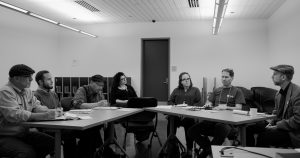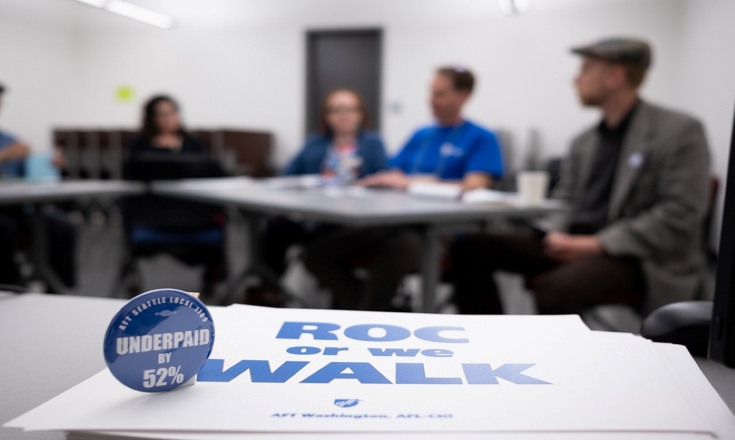The Seattle Colleges have run each year on a diminishing budget for as long as many can remember. Each new legislative round sees a 3%-5% operating budget cut that ripples across the campuses. The copy center is closed more often, the cafeteria cuts its hours back and the counseling services that some students rely upon are shuttered before the last classes of the day even begin.
The American Federation of Teachers (AFT) local 1789 has been raising the alarm both on campus and at the state legislature in Olympia. According to Chris Conley, the Faculty Senate President of Seattle Central, their pleas for a living wage for faculty and staff along with sincere upgrades to services have fallen on deaf ears. Conley, the AFT, and 119-pledged faculty members agree that the most recent round of budget appropriations proposed are barely a band-aid on the issue. They have decided to bring the issue home and are organizing a district wide faculty walkout on April 16th.

“The state has been neglecting community and technical colleges for too long,” says Alison McCormick, President of the AFT ProStaff Local 6550 and a 30 year veteran of the Seattle Colleges system. Both she and Conley share in the belief that they are being ignored in the discussion around funding higher education across the state. McCormick points towards a lip-service response from the state legislature and a changing economy in the King County area. “Tech economies strain every other profession,” she says of the seeming disparity between a booming Seattle economy and what AFT considers sub-par wages for its educators.
Washington clocks in at either the 10th or 11th most expensive state to live in depending on how you define the terms. But according to the terms defined by the internal study “Washington State Community and Technical Colleges: Faculty and Administrator Salary”, Washington has a Cost of Living Index (COLI) of 123.5, meaning that it’s 23.5% more expensive to live in Washington compared to the national average, with the Seattle-King County region reaching a COLI of 151.7, 51.7% over the national average.
“We have 100% support of faculty senates across the district, the union Executive Board, AFT Washington, our students, and potentially staff and administration,” a flyer from AFT recently read.
According to the same study, the average community and technical full-time faculty salary across the state is $61,153. In the Seattle-King County area, the average comes in slightly higher at $61,276. An adjunct makes about $32,000 in King County and often works the same amount of hours as a full time professor. The AFT is asserting that the Community and Technical colleges overly rely on these adjuncts as they comprise 70% of the instructional staff.
With 34 Community and Technical colleges across the state, the proposed budget inclusion of a $20 million increase for employees will result in about $24.50 dollars a paycheck according to the AFT. Contrast this with the amount being spent on Guided Pathways, $55,124,000, and people in positions like Chris Conley’s are not happy. “You will not increase retention and graduation with Guided Pathways unless you pay the front line teachers a living wage,” Conley commented recently.
His concerns are centered around the quality of education that these students will be receiving. More and more adjuncts, or people working on a part-time and mainly single quarter contract basis, have been taking on teaching core classes. Adjuncts work under routinely precarious scenarios; with a dangerously low wage, they are forced to take classes at several different colleges or moonlight in different fields to make ends meet. The non-priority hire adjuncts are the first to have their classes stripped and schedules rearranged to meet the needs of a guaranteed 3 classes a quarter per tenured faculty. As the Colleges begin to rely more heavily on these workers, the quality of the education that they are able to provide is at risk without the support of resources necessary to live in a booming economy.

Erin Gibbons, the Seattle Central Senate Part-time Representative is well versed on this inequality issue. “The lower pay, sparse resources, divided time across campuses, climate of lower status, along with the different textbooks and campus policies all affect the quality of instruction for the student,” Gibbons commented when asked about how part-time status and its equivalent pay affect on students. To her, the ratio of full to part time faculty needs to be addressed. “Contingent faculty help the system run smoothly by responding to fluctuations in enrollment, but when there are 70% of sections taught by adjuncts, it’s not working as intended. There should be 30% adjuncts to provide the flexibility the institution needs.”
The walkout planned at all three Seattle Colleges campuses on April 16th is an attempt to take these concerns all the way to the top. With faculty and Student Senate Union support they hope their concerns will be given the gravity not metered out in past interactions in Olympia. Their ROC or “(Re)invest in Our Colleges” campaign has three main demands; increase funding to Community and Technical Colleges by $500 million, fund cost-of-living-adjustments (COLAs) 100% instead of asking 65% and increase salaries 12% this year to match peer states. Beyond these figures, members of the AFT that I spoke with relayed the need for urgency, and feelings of not being taken seriously by both the Chancellor and those addressing the education budget. They see themselves as educators in an economic nose dive that has and will continue to affect their quality of life and ability to teach. And they want these concerns taken seriously.
Their hope is that students will support this walkout and its aims to draw attention to the factors that will affect students the most: the ability of their teachers to teach well and free from unnecessary economic burden. The same walkout tactic was attempted before in 2016, but the Union fell short of its goals. They point to a lack of unity that kept the action from reaching the mass they had wanted. This time around they have developed a much stronger base. “We have 100% support of faculty senates across the district, the union Executive Board, AFT Washington, our students, and potentially staff and administration,” a flyer from AFT recently read.
Bradley Lane, the Vice President of Instruction here at Central, says that Administration support is coming soon. Executive Administration is in the process of crafting the most meaningful message that will show support for the walk out. “The content of AFT’s message is important and administration wants to make sure that faculty, staff and students feel supported in their rights to assert it,” Lane said of the overall demands coming from AFT leadership. “Not just faculty are bearing the brunt of current economic forces,” he added, in response to how the nominal wage increases can have a ripple effect on students.
Without a shift in funding policy and a sincere effort by the state Senate and House, the Community and Technical Colleges will continue to chase their economic tails ad nauseam.
State legislature is under a mandate to fund K-12 education in this state. They are required to make sure that there is adequate resources for the public K-12 system to fund itself. But the situation is different for CTCs across the state. COLAs are not paid entirely through state spending when there is an increase. It is up to the public community colleges to first fund 35% of the needed budget and the state will then fund the remaining 65%. Each year the Seattle Colleges run at a deficit because of this funding structure. Inside of this legislative session it is expected that the Seattle Colleges will need to find 2 million dollars internally to pay its 35% share. This effectively means that the colleges must spend more with a running tally of less each year. Regarding this, Lane added, “The legislature has seen the need and importance in funding K-12 education. It’s time for them to realize something similar for public higher education, especially for the schools that are reaching the most first generation students and those with lower socioeconomic statuses.”
There are about 30 days left to ratify the spending bill in both the House and the Senate. The expectation is that there won’t be a need to be an extended session in order to reach an agreement. But whether the two legislative bodies will listen to the concerns and demands of the faculty, staff, administration and student body of the Community and Technical Colleges is yet to be seen. Certainly the fight will not end on April 16th with the show of collective action, as all parties involved have vowed to see a consistent and constant struggle for the funding that public secondary schools deserve.
According to everyone I spoke with inside the Seattle Central community, whether staff or faculty or administration, the sentiment of urgency was clear. Without a shift in funding policy and a sincere effort by the state Senate and House, the Community and Technical Colleges will continue to chase their economic tails ad nauseam. In some states, namely Arizona, there have been entire districts where the state has dis-invested in Community Colleges. Now those schools are floundering under diminishing enrollment and downward internal funding trends. The long-term outcome in this fight for higher education is not yet written and with each biennial budget passed the collective and unified response becomes increasingly prescient. Will we lose the fight for public higher education and, with it, foundational institutions like Seattle Central? For many the 16th and its possible implications will be a deciding factor.
To watch our brand new “Two Minute Warning” video about the walkout, please click here







Be First to Comment